Don't get me wrong: I would never suggest that NASA throttle back its efforts to explore the worlds around us. But I have to admit that, even for folks like me who follow space activities closely, things are getting a little crazy. Over the next several months, interplanetary exploration will rev up to a dizzying pace.
The first event occurred just a few days ago, when the twin STEREO spacecraft finally took up positions on opposite sides of the Sun. (We space junkies sometimes forget that the Sun is part of our solar system.) For the first time, solar scientists can monitor all of the Sun's disk at once — and that'll pay big dividends as solar activity ramps up in the months ahead.
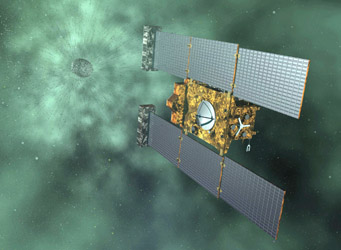
An artist's portrayal of the Stardust spacecraft approaching Comet Tempel 1 on February 14, 2011.
NASA
Coming up fast is a return visit to Comet 9P/Tempel 1. You'll recall that this 5-by-3-mile iceberg was the target of NASA's Deep Impact mission on July 4, 2005. When a 815-pound (370-kg) projectile slammed into the comet's nucleus, it unleashed an unexpected fireworks display of gas and dust.
Since then Tempel 1 has made one complete trip around the Sun, and on February 14th it'll again be in the crosshairs (this time just with instruments) of the Stardust spacecraft. This is a great example of how old spacecraft can do new tricks: Stardust completed its primary mission five years ago after zipping through the coma of Comet Wild 2 in early 2004 and dropping off a sample capsule when it swung past Earth. But the main spacecraft remained in solar orbit, and now it's posed to reconnoiter a second comet.
(Officially, the mission's name is now Stardust-NeXT — that latter bit standing for "New Exploration of Tempel 1" — but it's just too much of a stretch for my taste.)
In the best of all worlds, Stardust's camera would record the crater made by Deep Impact's copper-cored cannonball. But even if the nucleus has rotated it from view, there's still plenty to look at. The nucleus of Tempel 1 appears to have multiple layers and bizarre flows. Can a mountain-size blob of ice and dirt be geologically active? We'll have more answers to that question very soon.
There's no letup in the pace of solar-system exploration once Stardust has its hi-and-bye. In fact, NASA officials have dubbed 2011 the "Year of the Solar System." Well, truth be told, in their minds YSS began last October, when Deep Impact visited its second comet, 103P/Hartley 2, and it won't end until August 2012, when the not-even-launched-yet rover Curiosity (a.k.a. Mars Science Laboratory) reaches Mars.
Whatever. Here's a rundown of the other interplanetary headlines you can expect to see in the coming months:
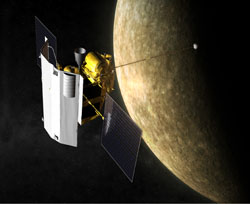
NASA / JHU-APL
March 18: After three warm-up flybys, NASA's Messenger spacecraft will fire its braking rocket and slip into a looping polar orbit around Mercury that comes within 125 miles (200 km) of its surface. Equipped with seven very capable cameras, spectrometers, and other instruments, Messenger has already made a trove of new discoveries about the innermost planet. But the real science breakthroughs (such as its interior structure) will come after the orbiter has made long-term observations. Messenger is a contraction of "Mercury Surface, Space Environment, Geochemistry, and Ranging."
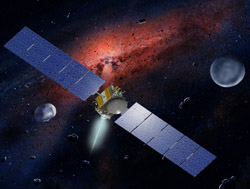
NASA / MCREL / W. Hartmann
July 16: The Dawn spacecraft will reach 4 Vesta, which is hands down the asteroid belt's most amazing chunk of rock: it's thought to have an iron–nickel core, a rocky olivine mantle, a crust, lava flows, and a giant crater. The spacecraft has been almost gliding toward Vesta using ion-fueled thrusters, and it will remain in orbit for a year before easing away and setting course for 1 Ceres. (Remarkably, Dawn isn't an acronym and doesn't stand for anything.) This mission's website is here, and I highly recommend the "Dawn Journal" written by chief engineer Marc Rayman.
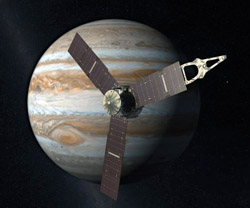
NASA / JPL
August 5: The launch date for NASA's ambitious Juno spacecraft. This is the first outer-planet-bound spacecraft to use solar-cell arrays, rather than plutonium power packs, to generate electricity. When it reaches Jupiter in 2016, Juno is to slip into a looping polar orbit that will both subject it to dangerously high radiation levels and, its science team hopes, answer key questions about the planet's composition, its interior structure, and from those how our solar system formed. Also not an acronym, Juno is named for the jealous god-sister-wife of Jupiter in Roman mythology. There's plenty of good background at NASA's website and the University of Wisconsin's.
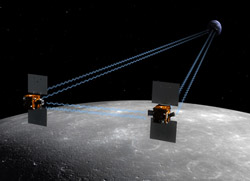
NASA / JPL
September 8: Lunar scientists will look on expectantly as the twin GRAIL spacecraft rocket skyward from Cape Canaveral, Florida. The Gravity Recovery and Interior Laboratory mission intends to fly these craft in tandem just 30 miles (50 km) above the lunar surface. By carefully tracking how the Moon's gravity alters the crafts' orbital motion, scientists hope to map the Moon's gravity field with unprecedented detail and, using that, derive the detailed structure of the lunar interior from crust to core.
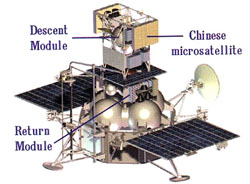
Lavochkin Association
November 8: If everything comes together in time, the Russian Space Agency plans to launch its problematic Phobos-Grunt mission. (Grunt is Russian for "ground".) Talk about a checkered history! Conceived in 1996 to land on the larger of Mars's two satellites and return a sample to Earth, this spacecraft has had more transformations than Cher at the Academy Awards! In its latest configuration, the spacecraft will carry a passenger, the Chinese-built spacecraft Yinghou 1, which will detach from Phobos-Grunt and orbit Mars for up to a year. Plans still call for the main spacecraft to land on Phobos, scoop up several samples totaling a total of 3 to 5½ ounces (85 to 160 g), and return them to Earth by early 2013.
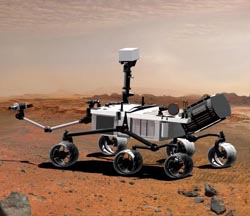
NASA / JPL
November 25: Another troubled mission, Mars Science Laboratory, will begin its flight to Mars. The primary scientific objective is straightforward: assess whether the Red Planet ever had an environment conducive to life — or still does. But MSL, renamed Curiosity after a Disney-inspired contest in 2009, has had a world of trouble getting to the launch pad. The beefy 1-ton lander should have already reached Mars, but development problems caused a two-year launch delay and ballooned its price tag to $2½ billion.
All these dates are subject to change, so to keep up to date I recommend that you check Ron Baalke's comprehensive Space Calendar for the latest schedules.
 4
4
Comments
Christine Shupla
February 11, 2011 at 1:10 pm
You didn't mention it, but because of this so-nicely described bonanza, NASA Science Mission Directorate is celebrating the Year of the Solar System (YSS). The YSS site has activities, a calendar of events, opportunities to list programs, and more! http://solarsystem.nasa.gov/yss
You must be logged in to post a comment.
theTónster
February 12, 2011 at 3:34 am
All right! Don Brownlee racks up more frequent space miles. More papers from him, I hope. He picked a fruitful career path. I remember when he was going from Seattle to Texas to launch balloons to collect space dust.
In the Epilogue to his nice book about Stardust, he pointed out something about home that we seldom think about; namely, the sheer improbability of our Earth-Moon System. The Moon is not in a stable orbit; long ago it was much closer, and likely helped stir up the beginnings of life here. In its long recession, it just happens to be the same angular size as the sun, just about the time humanity arises to look at Eclipses, and wonder about the coincidence. If it took all that to get to where we are now, then we are surely very rare creatures.
You must be logged in to post a comment.
Portugal Man
February 12, 2011 at 4:16 am
With all we now know rare creatures maybe - - Very Rare time will tell 🙂
You must be logged in to post a comment.
Russian Man
February 19, 2011 at 4:26 pm
In this case with Phobos-Grunt, it seems being more precise to translate "grunt" as just "soil" (of which it will "scoop up several samples while on Phobos")...a lovely article...
You must be logged in to post a comment.
You must be logged in to post a comment.